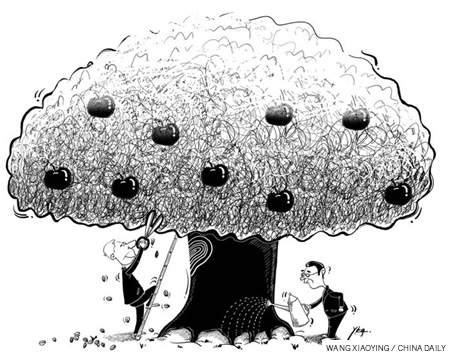Center
Can Hu's US visit boost Asia?
Updated: 2011-01-28 08:05
By Amitendu Palit (China Daily)

President Hu Jintao's state visit to the United States last week was in the backdrop of a major realignment in the global economic order following the financial crisis. During Hu's visit to the US in April 2006, the world economy, despite experiencing the initial impacts of a gradual shift in the global economic balance toward Asia was not overtly reliant on Asia for sustaining growth.
| ||||
The US received President Hu with the knowledge that not only was China now the second largest economy in the world, but also it held the key to the US' future economic prospects.
As expected, economics dominated the visit. Though there were hardly many movements on the exchange rate or the trade imbalance, notable business deals were signed. Reports suggest the value of these deals to be about $45 billion, which will support 235,000 jobs for the US. For a troubled US economy, the deals offer fresh hope, particularly at a time when disappointment over lack of employment has led to a loss of political goodwill for US President Barack Obama.
Stronger business ties between China and the US that are expected following Hu's visit are good news for most Asian economies, particularly developing countries. China's economic rise has been a source of growth for the rest of the region. China grew by 10.3 percent a year in the last decade, far higher than the world growth of 2.6 percent.
During this time, developing Asia grew by 6.7 percent. The industrial economies of Hong Kong and Taiwan, and the Republic of Korea (ROK) and Singapore grew by 6.4 percent as a group, while the five Southeast Asian economies (Indonesia, the Philippines, Vietnam, Malaysia and Thailand) grew by 5.2 percent. These growth rates are far higher than that of the G7, or group of the richest countries, which was only 1.5 percent.
China's growth and its extensive linkages with production networks in Asia have fuelled growth elsewhere in the region. This momentum should be retained as China's economic activity expands through new business ties with the US. The ROK has already expressed faith in China's strong growth providing impetus to its exports. Similar sentiments are likely to prevail across developing Asia, too.
Chinese investments in the US are expected to increase following Hu's visit. Depressed asset prices in the US coupled with a stiffening yuan can encourage several Chinese companies to set up bases in the US through mergers and acquisitions. This will be consistent with China's efforts to reorient its manufacturing exports more toward high-end products.
Chinese companies eyeing the US market either for investment or exports are likely to concentrate more on value-added high-quality products suited for high and middle-income consumers. That will make many of these firms give up low-cost assembling operations. And that again is good news for manufacturers in India, Vietnam, Malaysia and Thailand, because they will have the opportunity to fill up the space vacated by Chinese firms and plant themselves in global supply chains.
Climate change is a major concern for Asia, particularly the monitoring and verification requirements that the US and other developed countries want to impose on developing countries for using resources from the climate fund to adapt to and fight global warming. China, along with India, Brazil, and South Africa, has been opposing the US and other developed countries on this demand.
Progress on climate change is unlikely till the US and China agree on contentious issues. Hu's visit may not have produced a specific outcome in this respect, but it is heartening to see Chinese and American energy companies such as China Power Investment Corp, Alcoa, America Electric Power, China Huaneng, Shenhua Group and GE Energy collaborating on clean-energy projects with a focus on low-carbon technologies.
For Asian countries that are highly vulnerable to climate change and clueless about the quality of future international response, these collaborations offer hope in terms of US and Chinese convergence at least in corporate efforts to address climate concerns.
Hu's visit has left little doubt about the US inability to fully accept and treat China as an economic equal. This was evident from reactions highlighting downsides of the Chinese economy such as the lack of adequate instruments of consumer finance and regulations favoring domestic enterprises and imposition of restrictions on Chinese exports of renewable technologies just before President Hu's visit.
China, despite being a developing country, is breathing down the US neck. But Americans don't want to accept it just like they don't want to acknowledge their country's economic decline.
China symbolizes an economically robust Asia drawing inspiration from fast-growing developing countries. For these countries, it is important to realize that Asia's growing influence in the world economy is unlikely to be accepted wholeheartedly by the US and the developed West. It will require time and even better economic performance from all, including China, to establish and convince the West about the current century being an Asian century.
The author is head of development programmes and visiting senior research fellow at the Institute of South Asian Studies of the National University of Singapore.
Specials

President Hu visits the US
President Hu Jintao is on a state visit to the US from Jan 18 to 21.

Ancient life
The discovery of the fossile of a female pterosaur nicknamed as Mrs T and her un-laid egg are shedding new light on ancient mysteries.

Economic Figures
China's GDP growth jumped 10.3 percent year-on-year in 2010, boosted by a faster-than-expected 9.8 percent expansion in the fourth quarter.



